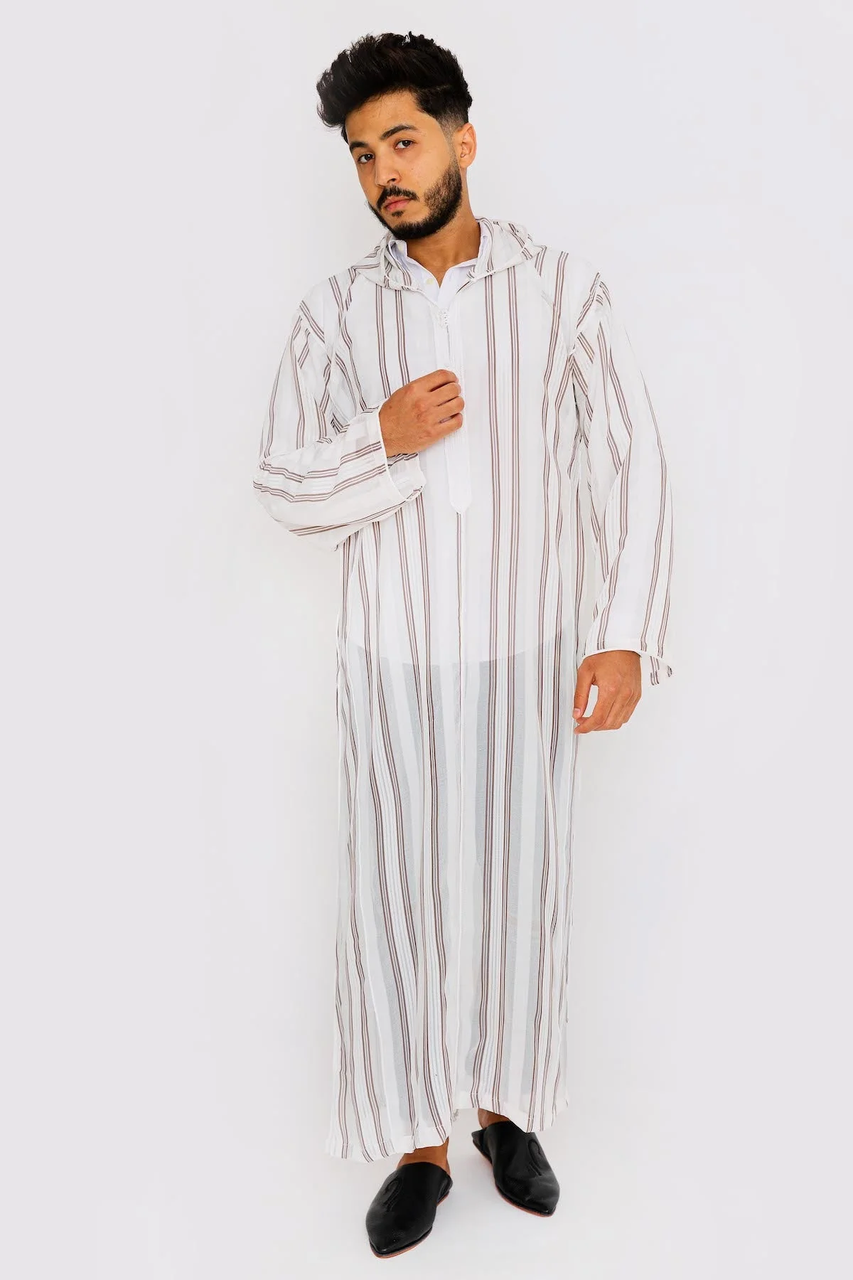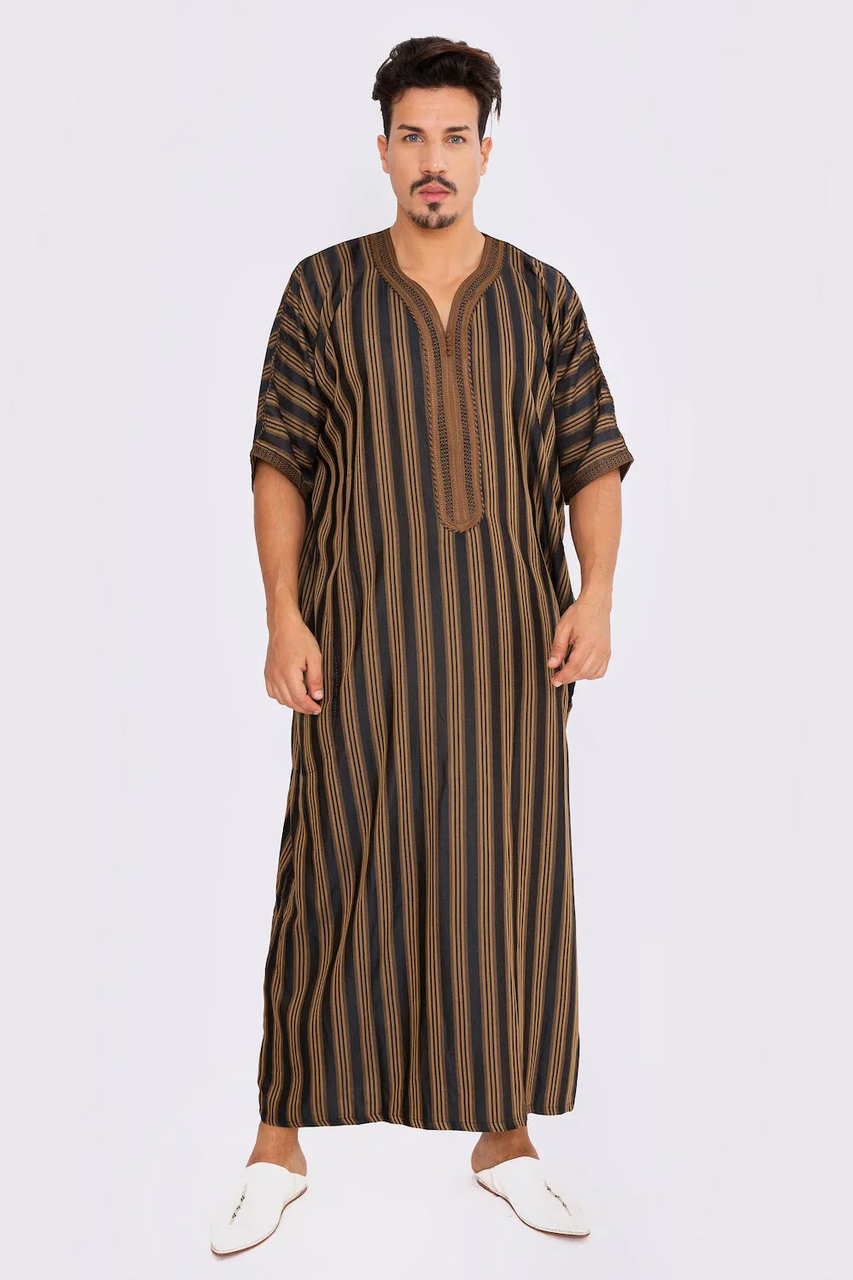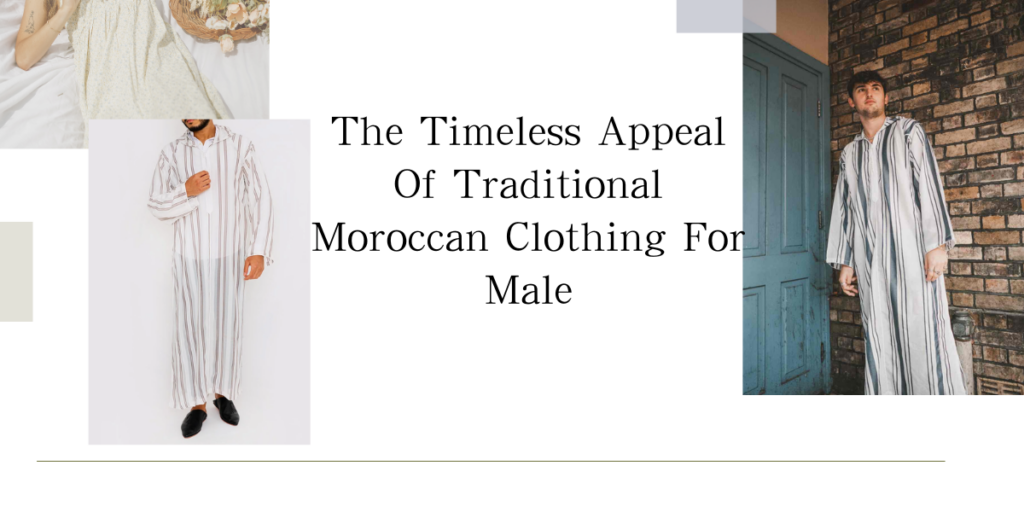Moroccan clothing has a rich history dating back to ancient times, with various influences from Arab, African, and European cultures. Traditional Moroccan clothing is an essential aspect of the country’s cultural heritage and is still worn by many people today. In this article, we will explore the traditional men clothing in Morocco, the materials used, colors, and patterns, modern adaptations of traditional clothing, and the enduring appeal of this fashion.
Traditional Moroccan Clothing For Men
Moroccan traditional clothing is an expression of the country’s rich cultural heritage. Men’s traditional clothing is composed of several distinctive pieces that are both stylish and practical.
- Djellaba
The Moroccan Djellaba is a long, loose-fitting robe with a pointed hood that is worn by men throughout Morocco. It is made of a comfortable, lightweight fabric such as cotton or wool, which makes it ideal for the country’s warm climate. The Djellaba can be worn as a casual garment around the house or as formal attire for special occasions. It is often paired with a scarf or a fez.
- Kaftan
The Moroccan Kaftan is another popular traditional garment for men in Morocco. It is a long-sleeved robe that is made from silk or cotton and can be worn with or without a hood. The Kaftan is often adorned with intricate embroidery and is typically worn during formal occasions such as weddings and religious celebrations. It is also common to see men wearing Kaftans during Ramadan, the holy month of fasting.
- Jabadour
The Moroccan Jabadour is a long, sleeveless tunic that is typically worn over a shirt and trousers. It is often made from lightweight cotton or linen and is popular in the southern regions of Morocco. The Jabadour is commonly worn during casual occasions or for work. It is typically paired with a traditional hat such as a Fez or Tarboush.
- Gandora
The Moroccan Gandora is a long-sleeved tunic that is similar to the Djellaba. It is typically made from wool or cotton and is often worn during cooler weather. The Gandora is commonly worn as a casual garment or for work, and it is typically paired with a traditional hat such as a Fez or Tarboush.
- Takchita
The Takchita is a long, flowing robe that is often worn by men during special occasions such as weddings and religious festivals. It is typically made from luxurious materials such as silk or velvet and is adorned with intricate embroidery and beading. The Takchita is often worn with a traditional headpiece such as a Fez or a Turban.

Materials Used In Traditional Moroccan Clothing
- Silk
Silk is a luxurious fabric that has been used for centuries in Moroccan clothing. It is highly prized for its softness, sheen, and durability. The use of silk in traditional Moroccan clothing is mostly limited to formal occasions such as weddings, religious ceremonies, and festivals. The fabric is often embellished with intricate embroidery and beadwork to add an extra touch of elegance.
- Cotton
Cotton is a versatile and breathable fabric that is widely used in Moroccan clothing. It is especially popular in the summer months when the weather is hot and humid. Cotton is easy to dye, and it is often used in vibrant colors and bold patterns. It is commonly used in the production of traditional Moroccan djellabas, which are loose-fitting robes that are worn by both men and women.
- Wool
Wool is another common material used in traditional Moroccan clothing, especially during the winter months. It is prized for its warmth, durability, and ability to retain heat even when wet. Wool is commonly used in the production of the jabadour, which is a long, hooded cloak worn by Moroccan men in rural areas. The jabadour is often decorated with intricate embroidery and tassels.
- Linen
Linen is a lightweight and breathable fabric that is commonly used in traditional Moroccan clothing. It is especially popular during the hot summer months when the weather is dry and hot. Linen is often used to make the traditional kaftan, which is a long, flowing robe that is worn by both men and women. The fabric is often embellished with intricate embroidery and beadwork.
- Embroidery
Embroidery is an essential element of traditional Moroccan clothing. It is used to add intricate designs, patterns, and textures to the fabric. Embroidery is commonly used to decorate the cuffs, collars, and hems of the djellaba, kaftan, and jabadour. The embroidery is often done by hand, and it can take weeks or even months to complete a single garment.
Colors And Patterns In Traditional Moroccan Clothing
In traditional Moroccan clothing, colors and patterns have significant meanings and symbolisms. For instance, the color white is often associated with purity and spirituality, while green represents paradise, and blue symbolizes protection against evil. Red is associated with love, fertility, and power, while gold and silver symbolize wealth and luxury. Black is a symbol of resistance and mourning.
Moroccan textiles are also known for their intricate and colorful patterns, which are often inspired by Islamic art and architecture. Some of the most popular patterns include geometric shapes, floral motifs, and calligraphy. These patterns are often combined with bold colors to create striking and visually appealing designs.
One of the most famous patterns in Moroccan clothing is the “tarz,” which is a unique pattern made up of various geometric shapes, such as squares, triangles, and diamonds. The tarz pattern is often used in traditional Moroccan carpets, fabrics, and clothing, and it is believed to have originated from the Berber tribes.
Modern Adaptations Of Traditional Moroccan Clothing
As Moroccan culture continues to evolve, so does its traditional clothing. Modern adaptations of traditional Moroccan clothing have emerged in recent years, incorporating elements of Western fashion to create a unique fusion of styles. This fusion can be seen in the use of new materials, colors, and patterns.
One example of this fusion is the “Moroccan dress shirt,” which blends elements of the traditional Moroccan djellaba with the style of a Western dress shirt. This shirt typically has a collar and buttons down the front, but still features the flowing fabric and traditional embroidery of the djellaba.
Contemporary styles have also emerged, which take inspiration from traditional Moroccan clothing but add modern twists. One such style is the “urban kaftan,” which features a shorter length and a more fitted shape than the traditional kaftan. It is often made with modern materials, such as denim or leather, and may incorporate non-traditional colors and patterns.
These modern adaptations and contemporary styles are a testament to the enduring appeal of traditional Moroccan clothing. While they may incorporate new elements, they still hold true to the cultural significance and heritage of clothing.

Conclusion
Traditional Moroccan men ‘s clothing is an essential aspect of Moroccan culture. It represents the country’s rich history and heritage, and it is an integral part of the Moroccan identity. The enduring appeal of traditional Moroccan clothing lies in its intricate designs, beautiful materials, and significant meanings. It is important to preserve this cultural heritage for future generations to come.
FAQs:
Q1: What is the significance of traditional Moroccan clothing?
Q1: Traditional Moroccan clothing has significant cultural and historical value. It reflects the country’s diverse ethnic and religious heritage, and the different regions of Morocco have their own unique styles of clothing. Traditional clothing is also an important part of Moroccan celebrations and ceremonies, such as weddings and religious holidays.
Q2: What materials are used in traditional Moroccan clothing?
Traditional Moroccan clothing is made using a variety of materials, including silk, cotton, wool, and linen. These materials are chosen for their durability, comfort, and ability to regulate body temperature in Morocco’s varying climates.
Q3: What colors and patterns are popular in traditional Moroccan clothing?
Colors and patterns are an important aspect of traditional Moroccan clothing. The colors used in clothing have symbolic meanings, with white representing purity and black symbolizing power and authority. Popular patterns include geometric designs and floral motifs, often embellished with embroidery or beading.
Q4: How has traditional Moroccan clothing been adapted to Western fashion?
Traditional Moroccan clothing has been adapted to Western fashion in various ways. For example, designers have incorporated traditional fabrics and patterns into modern designs, creating a fusion of Moroccan and Western styles. Additionally, Western fashion has influenced the design of traditional Moroccan clothing, with some styles incorporating more fitted cuts and modern accessories.
Q5: Why is it important to preserve traditional Moroccan clothing?
It is important to preserve traditional Moroccan clothing as it is a significant aspect of the country’s cultural heritage. Traditional clothing is also an important source of income for many artisans and craftspeople who create and sell these garments. By preserving and promoting traditional clothing, we can help support these artisans and ensure that this important aspect of Moroccan culture is passed down to future generations.
